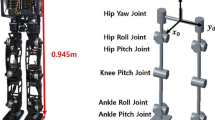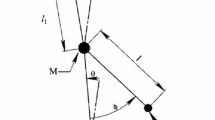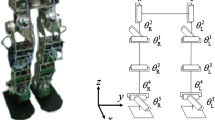Abstract
This study investigates the effect of vertical movements of the pelvis on the joint of a biped robot. We evaluate experimentally two cases of walking on flat terrains and avoiding a toll bar obstacle. The experimental results show that the torque and velocity of the knee joint vary with the vertical movement of the pelvis. The knee joint velocity can be reduced when walking with the vertical movement compared to that when walking without the vertical movement of the pelvis. Based on the experimental results, the vertical movement of the pelvis can increase the stride lengths or relax the knee-actuator performance requirements. In addition, the trajectories of the center of mass (CoM) generated to avoid a toll bar obstacle using the preview control that includes the vertical motion of the CoM are compared to those using the preview control that neglects the vertical motion of the CoM. The results show that the trajectory generated by including the vertical motion of the CoM can reduce energy consumption and walk more stable.



















Similar content being viewed by others
References
Sakagami, Y., Watanabe, R., Aoyama, C., Matsunaga, S., Higaki, N., & Fujimura, K. (2002). “The intelligent asimo: System overview and integration,” in IEEE/RSJ international conference on intelligent robots and systems, vol. 3. IEEE, pp. 2478–2483.
Chestnutt, J., Lau, M., Cheung, G., Kuffner, J., Hodgins, J., & Kanade, T. (2005). “Footstep planning for the honda asimo humanoid,” in Proceedings of the 2005 IEEE international conference on robotics and automation.IEEE, pp. 629–634.
Feng, S., Xinjilefu, X., Atkeson, C.G., & Kim, J. (2015). “Optimization based controller design and implementation for the atlas robot in the darpa robotics challenge finals,” in 2015 IEEE-RAS 15th International conference on humanoid robots (Humanoids). IEEE, pp. 1028–1035.
Kuindersma, S., Deits, R., Fallon, M., Valenzuela, A., Dai, H., Permenter, F., et al. (2016). Optimization-based locomotion planning, estimation, and control design for the atlas humanoid robot. Autonomous Robots, 40(3), 429–455.
Park, I.-W., Kim, J.-Y., Lee, J., & Oh, J.-H. (2006). “Online free walking trajectory generation for biped humanoid robot khr-3 (hubo),” in Proceedings 2006 IEEE International conference on robotics and automation, 2006. ICRA 2006. IEEE, pp. 1231–1236.
Wang, H., Zheng, Y.F., Jun, Y., & Oh, P. (2014) “Drc-hubo walking on rough terrains,” in 2014 IEEE International conference on technologies for practical robot applications (TePRA). IEEE, pp. 1–6.
Kaneko, K., Harada, K., Kanehiro, F., Miyamori, G., & Akachi, K. (2008). “Humanoid robot hrp-3,” in 2008 IEEE/RSJ International conference on intelligent robots and systems. IEEE, pp. 2471–2478.
Akachi, K., Kaneko, K., Kanehira, N., Ota, S., Miyamori, G., Hirata, M., Kajita, S., & Kanehiro, F. (2005). “Development of humanoid robot hrp-3p,” in 5th IEEE-RAS International conference on humanoid robots, 2005. IEEE, pp. 50–55.
Metta, G., Sandini, G., Vernon, D., Natale, L., & Nori, F. (2008). “The icub humanoid robot: an open platform for research in embodied cognition,” in Proceedings of the 8th workshop on performance metrics for intelligent systems, pp. 50–56.
Harada, K., Miura, K., Morisawa, M., Kaneko, K., Nakaoka, S., Kanehiro, F., Tsuji, T., Kajita, S. (2009). “Toward human-like walking pattern generator,” in 2009 IEEE/RSJ International conference on intelligent robots and systems. IEEE, pp. 1071–1077.
Inman, V. T., & Peltier, L. F. (1993). Human locomotion. Clinical Orthopaedics and Related Research, 288, 3–9.
Ryu, K., Yoo, J., Back, J., & Park, I.-W. (2020). Preview control-based online walking pattern generation for biped robots with vertical center-of-mass motion. International Journal of Precision Engineering and Manufacturing, 21(9), 1653–1661.
Ogura, Y., Lim, H.-o., & Takanishi, A. (2003). “Stretch walking pattern generation for a biped humanoid robot,” in Proceedings 2003 IEEE/RSJ International conference on intelligent robots and systems (IROS 2003)(Cat. No. 03CH37453), vol. 1. IEEE, pp. 352–357.
Omran, S., Sakka, S., & Aoustin, Y. (2016). Effects of COM vertical oscillation on joint torques during 3D walking of humanoid robots. International Journal of Humanoid Robotics, 13(04), 1650019.
Li, Z., Vanderborght, B., Tsagarakis, N.G., & Caldwell, D.G. (2010). “Human-like walking with straightened knees, toe-off and heel-strike for the humanoid robot icub,”
Gruss, L. T., Gruss, R., & Schmitt, D. (2017). Pelvic breadth and locomotor kinematics in human evolution. The Anatomical Record, 739–751.
Kajita, S., Kanehiro, F., Kaneko, K., Fujiwara, K., Harada, K., Yokoi, K., & Hirukawa, H. (2003). “Biped walking pattern generation by using preview control of zero-moment point,” in 2003 IEEE International conference on robotics and automation, vol. 2, pp. 1620–1626.
Anderson, B.D. & Moore, J.B. (2007). Optimal control: linear quadratic methods. Courier Corporation
Koenig, N., & Howard, A. (2004). Design and use paradigms for gazebo, an open-source multi-robot simulator. IEEE/RSJ International conference on intelligent robots and systems (pp. 2149–2154). Japan, Sep: Sendai.
Smith, R. et al., “Open dynamics engine,” (2005). [Online]. Available: http://www.ode.org
Funding
The present research has been conducted under the Research Grant of Kwangwoon University in 2020, and it has been supported by the National Research Foundation of Korea(NRF) grant funded by the Korea government (MSIT) (2019R1A4A1029003).
Author information
Authors and Affiliations
Corresponding author
Additional information
Publisher's Note
Springer Nature remains neutral with regard to jurisdictional claims in published maps and institutional affiliations.
Rights and permissions
About this article
Cite this article
Yoo, J., Ryu, K., Back, J. et al. Advantages of Vertical Pelvic Movement in Bipedal Gaits for Increasing Stride Length and Reducing Actuator Power Requirements. Int. J. Precis. Eng. Manuf. 23, 291–303 (2022). https://doi.org/10.1007/s12541-021-00541-x
Received:
Revised:
Accepted:
Published:
Issue Date:
DOI: https://doi.org/10.1007/s12541-021-00541-x




